
3 Profitable Businesses That Rely On Email Marketing
We often think of email as a vehicle, transporting information from your company to customers.
That email might offer the latest product updates or a helpful consumer tip. However, email also can initiate long-term brand engagement and facilitate new sales.
With 34% of Americans checking email throughout the day, your customers are probably engaging with their email more often than they are engaging with your product.
So why not make something worth your customers’ time and attention?
What If Email Was Your Only Product?
When email is your only product, it inevitably raises the stakes for making something people desire. By learning from businesses built on the back of email alone, we can see how much more we can do in our own emails.
- Scott’s Cheap Flights converts free users with the fear of missing out (FOMO)
- Death to Stock segments by hunger to increase engagement
- theSkimm creates a word-of-mouth machine for endless referrals
First, let’s talk about how Scott’s Cheap Flights activates its user base of travel enthusiasts.
Convert Free Users With FOMO
Growing an email subscriber list is challenging, and monetizing it into a business with $4 million ARR and 20 employees might seem impossible. By hooking users into great travel deals for free, Scott’s Cheap Flights uses FOMO to amp up conversion rates for its 600K subscribers.
With daily engagement and sometimes more, the company delivers valuable emails to convert its subscribers.
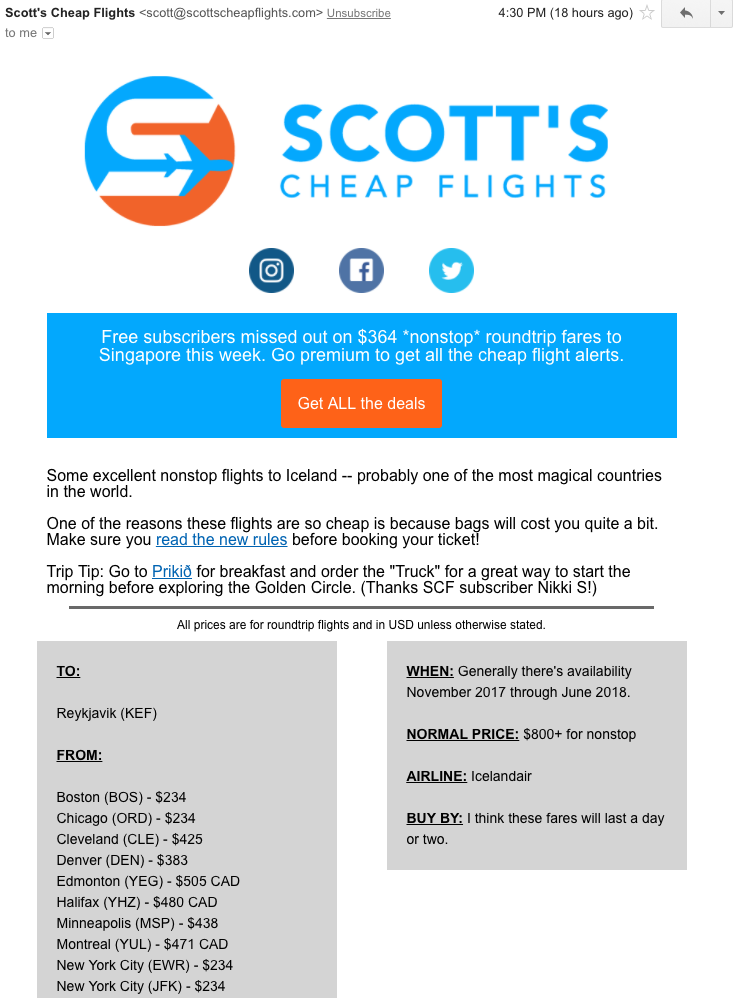
In the email above, value is expressed throughout the entire message, everywhere from realistic cost breakdowns, to when the fares will likely expire, to where to eat when you arrive at your destination. The email eases the pains of budget traveling and lets customers know how to make a magical vacation possible.
Scott’s Cheap Flights also adds urgency. The notes section encourages readers to follow through with booking:

By allowing free users to sample the full product with specific, time-sensitive deals, the company sets up the calls to action (CTAs) to upgrade the service. In an interview, the founder describes the upsell strategy as such:
“The only real promotion we do is to put a little note or two in the free emails to let subscribers know about the types of deals they missed out on. We’re trying to hit the right balance of not scaring off free users by bombarding them with upgrade requests, while also making sure that those free subscribers who might want more know about the premium option.”
The language of Scott’s CTAs is classic FOMO. This fear of a future missed opportunity is highly motivating, especially when the opportunity is definite — a particular location for a particular price.

Outside of the actual emails, Scott’s Cheap Flights regularly launches promotions and events to push current free users to convert into premium subscribers. One strategy included a simple price increase. The founder describes why price increases are a surprisingly valuable conversion tactic:
“At first it was scary to increase prices… though the fear was tempered by the fact that we kept people grandfathered on their original plans. But we noticed an unexpected twist: During the 48 hours preceding the scheduled price increase, sales skyrocketed. It was a eureka moment. Nothing like an impending price increase to nudge fence-sitters into upgrading now rather than putting off the decision. Plus with a built-in audience of free subscribers, we had a group of people much easier to upgrade.”
Realizing the low-hanging fruit of so-called fence sitters, Scott’s Cheap Flights targeted this same group with a Black Friday deal. In late November 2016, their team offered yearly subscriptions for $19. The offer was only good for 72 hours and caused a huge spike in premium purchases, proof of which Scott provided in one of his five Reddit AMAs:

Scott’s Cheap Flights proves that the first step to monetizing your email subscriber list is delivering a free product people love. With a few well-placed, highly targeted calls to action, you can increase conversions without constantly selling.
Segment by Hunger to Increase Engagement
If you want to boost repeat customers, zero in on the audience that needs you the most. Death to Stock has made their 200,000+ subscribers happy by increasing communication to those who have shown interest and reducing outreach to less-engaged customers.
Death to Stock’s audience is a particular group of people with a specific problem — creatives desiring inspiration. They work differently from most stock photo sites. Customers come to them searching for a place to start, not to find finishing touches. The company wants to discourage one-off customers and encourage people who want to solve their ongoing challenges.
To help users take that leap, each monthly email features a story around the photo pack. This strategy builds both context and curiosity leading into the download.
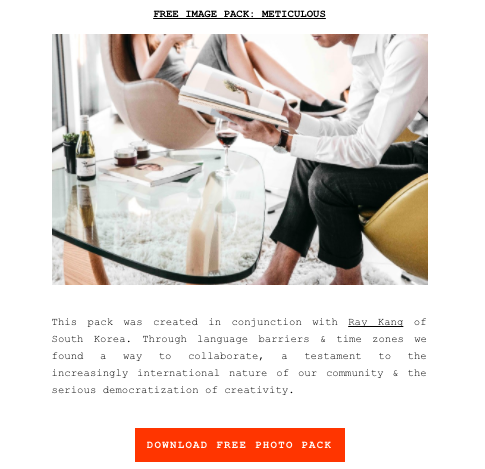
Of his goals, founder David Sherry has said, “When it comes down to it… did I encourage someone today? Did I equip them to create their best work? Did I help them break some rules by breaking some myself?”
Their commitment to an audience in the discovery phase of creativity has led them to a somewhat counterintuitive segmentation strategy. Instead of focusing on particular behaviors or preferences, “we segment based on hunger. We know that when people engage a lot, they have a pain point. We relieve that by sending them more content.”
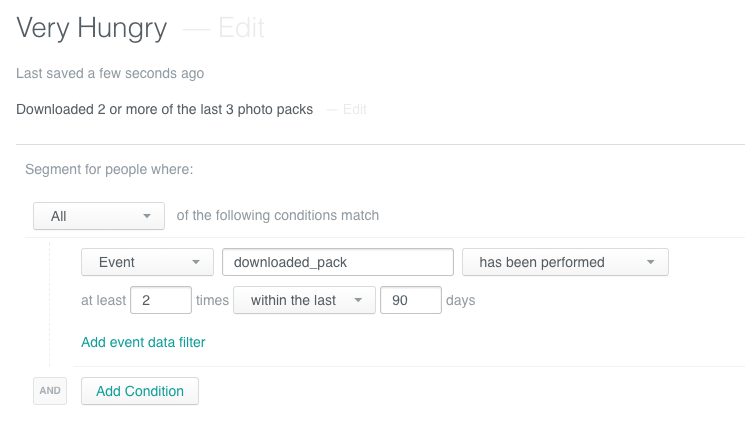
This results in a delightful customer experience for the users that interact with their product the most and no complaints from people who don’t really need it.
Sometimes Death to Stock will send surprise emails to its hungriest subscribers outside of the regular cadence, containing new photos or collaborations. These rewards don’t just go to premium subscribers — free users get them, too.
In another interview, Chief Operating Officer Shaun Singh notes the unexpected end goal of their engagement strategy:
“Eventually what happens—and we always want this to happen—is that they get really, really good at their craft and they end up leaving. Either because they’ve honed their creative eye and end up taking their own images or now they know exactly what they want so they go to buy one-off images.”
Without the pressure to keep customers for life, Death to Stock doesn’t waste any resources reeling disengaged customers back in. By implementing segmentation, they’ve defined a niche in the stock photo market that allows them to grow based on demand and help more customers who depend on their service.
Create a Word-of-Mouth Machine for Endless Referrals
Once users are actively engaging with your emails, let them know how to spread the word. With a 35% open rate and 3.5 million active subscribers, theSkimm’s secret to constant growth is referral emails, or refer-a-friend messages.
theSkimm’s daily news digest is made for quick reading and easy sharing. Shareability is embedded in the content.
The founders developed a voice that sounds like a best friend who knows the latest gossip. Each section has a quippy headline and prominent share buttons, making it easy to tell your friends. The top of the email almost always includes a referral link.
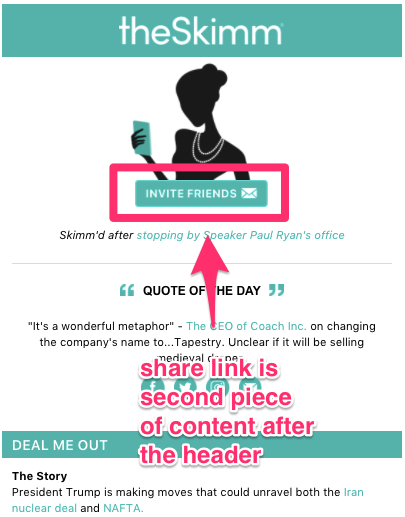
For those who share theSkimm more than once in a while, the company offers rewards and incentives for continued loyalty. As a result, the Skimm’bassador program has grown to include over 13,000 members who have referred more than 10 people each.
The first hint of the VIP treatment subscribers receive is in the birthday shoutouts at the bottom of each Skimm email. The asterisks, indicating Skimm’bassadors, serve dual purposes — to give individuals extra recognition and also to create visible social proof of theSkimm’s popularity.
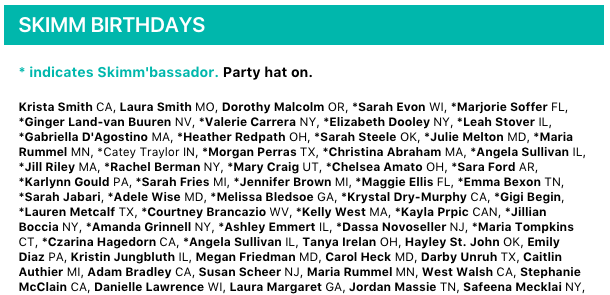
theSkimm’s goal is to be the catalyst for cocktail party conversations both online and offline, and to do so they need to know what their readers are talking about. They use a combination of unsolicited feedback and outbound user surveys to find that pulse and incorporate it in editorial decision-making.
“[T]hankfully we get a LOT of daily feedback. It helps us understand a) what we are doing well, b) what we could be doing better, and c) what are things we could be doing, but may not have been thinking about,” growth lead Ryan Stuczynski says.
Through their feedback analysis, theSkimm has also tapped into how their readers talk to one another. To aid Skimm’bassadors in their sharing efforts, there’s a guide for sharing best practices, including this section:
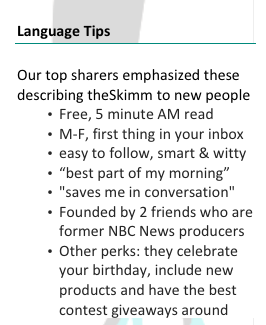
Through its pitch-perfect tone, theSkimm creates an intimate bond amongst customers. And with its referral emails, they’ve started a conversation that never really ends.
Making the Most of Your Email
Email can be a useful tool throughout the entire customer lifecycle for boosting activation, retention, and advocacy. Since email is such a personal medium, it can directly influence your customers.
Even if email isn’t your main product, it can carry a lot of weight. By sending emails that go after big product goals, you can create communication that matters.
What role does email play in your customer journey? Share your thoughts below.